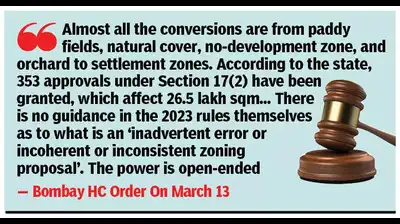Trending
HC order nullifying Sec 17 (2) rules, norms comes into force
Panaji: The high court judgment striking down the controversial rules and guidelines under Section 17(2) of the TCP Act in “public interest” became effective after the expiry of six weeks from the date of the verdict on March 13.

Referring to the recovery of conversion fees, Pangam said that in individual cases, if the court finds the land was converted without merit, the conversion would be set aside.
With govt keeping its word of not approaching Supreme Court in the matter, all eyes are now on its next move. The affected land developers are hoping for some relief from the TCP department within the framework of the TCP Act.
Claude Alvares, the director of Goa Foundation and the petitioner, said, “We assume that the judgment is final. The matter has been listed for hearing in June. All the individual cases will be heard by the court.”
Alvares added, “We have filed a caveat in the Supreme Court. Had any special leave petition been filed in the court, we would have received a notice. As no notice has been received, we assume the HC judgment is final.”
After the judgment was delivered on March 13, govt sought a stay on the operation of the judgment for six weeks, which was accepted by the court.
“Almost all the conversions are from paddy fields, natural cover, no-development zone, and orchard to settlement zones,” the HC said, adding that according to the state, 353 approvals under Section 17(2) have been granted, which affect 26.5 lakh sqm.
“The 2023 rules confer unfettered and unguided authority on the executive to interpret what is meant by an inadvertent error or what is an inconsistent/incoherent zoning proposal,” the HC said. “There is no guidance in the 2023 rules themselves as to what is an ‘inadvertent error or incoherent or inconsistent zoning proposal’. The power is open-ended.”
Such “plot-by-plot conversion, creating a zone within a zone virtually has the effect of mutilating the Regional Plan prepared after such an elaborate exercise,” the high court had said.
While the affected parties have the scope to approach the apex court to seek relief, they are not betting on this because govt made a volte-face on challenging the verdict in the Supreme Court due to public pressure.
Two days after the HC struck down the rules and guidelines, TCP minister Vishwajit Rane said that govt will tweak the rules and guidelines in line with the HC directions and make Section 17(2) operational.
Rane made a U-turn over his statement to challenge the HC order in the Supreme Court and said that he will not do so.
End of Article
Follow Us On Social Media









